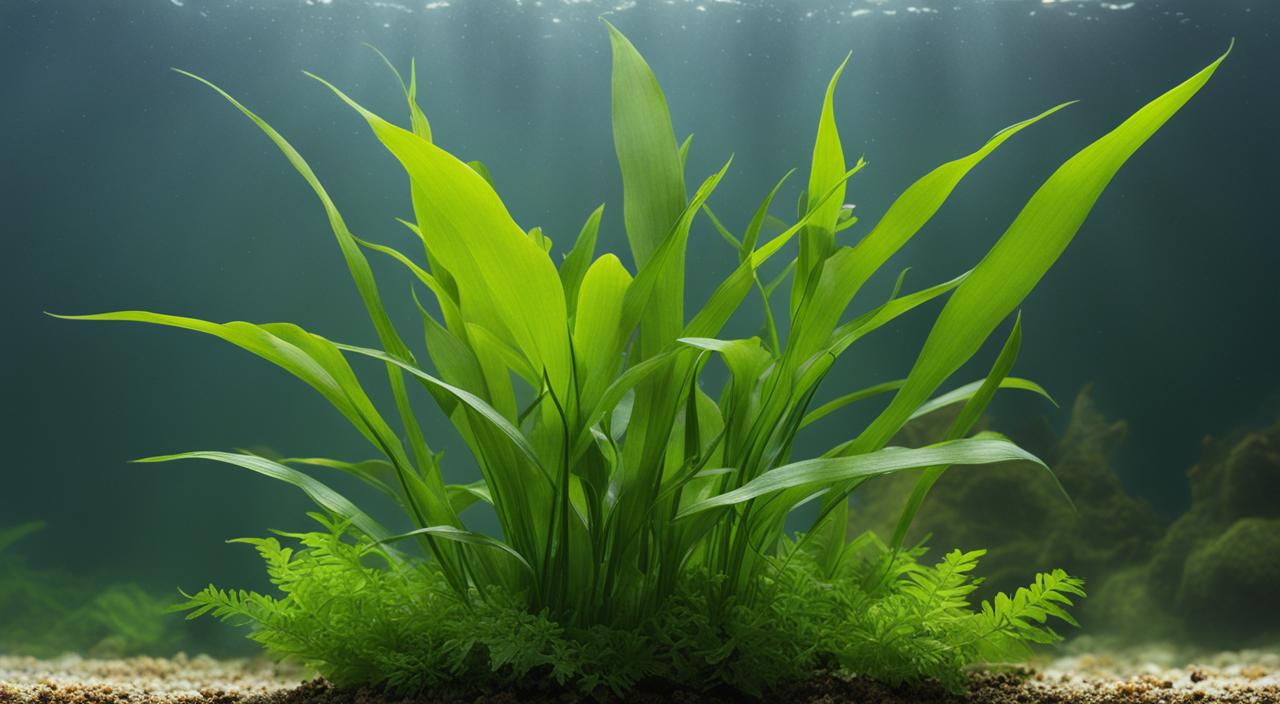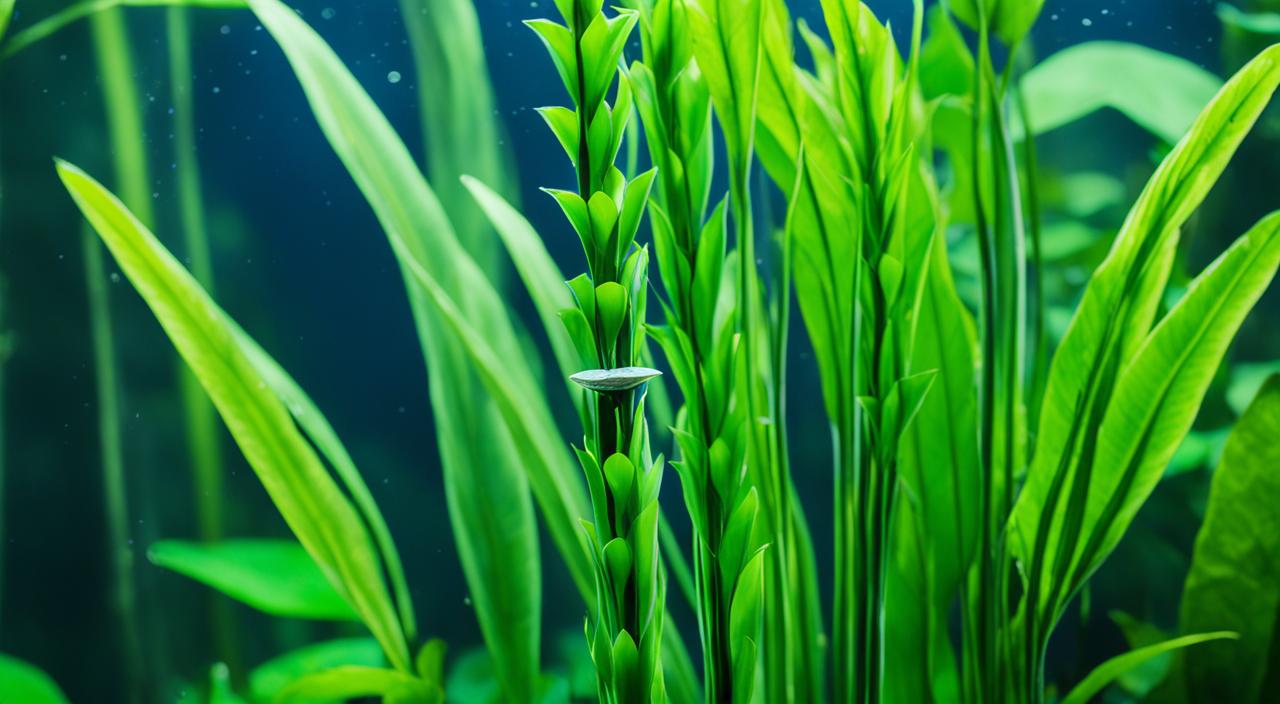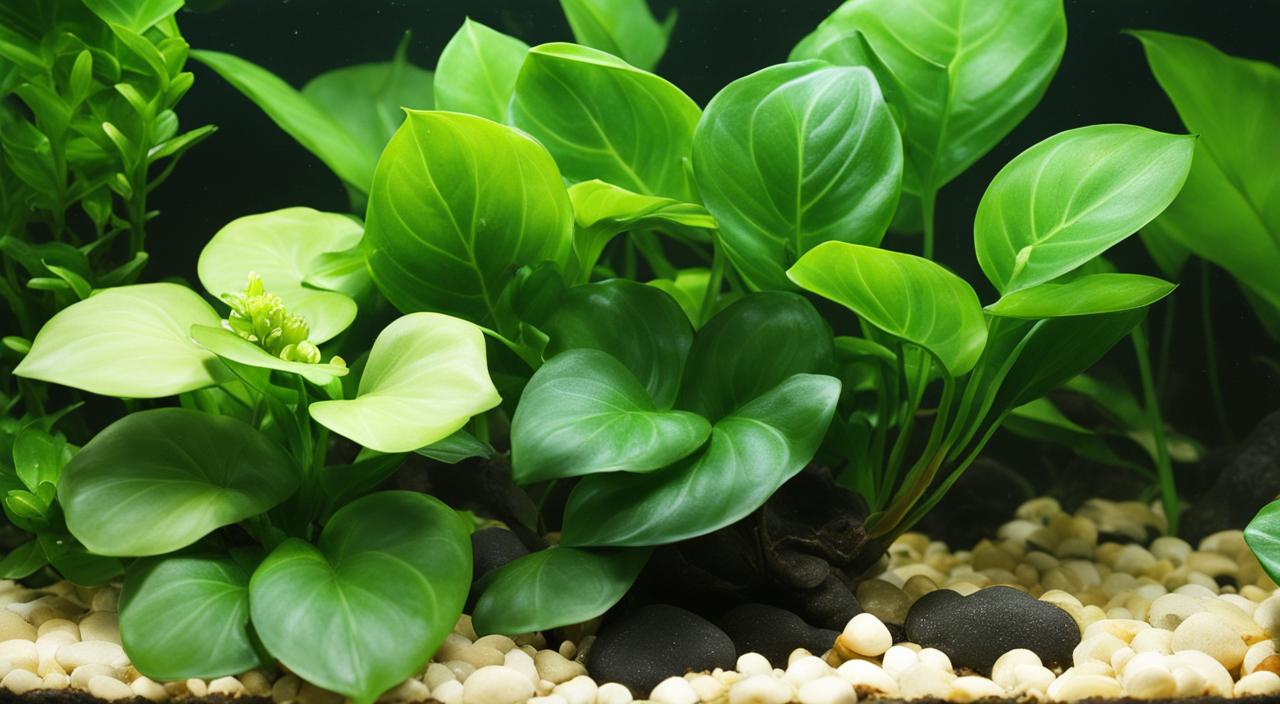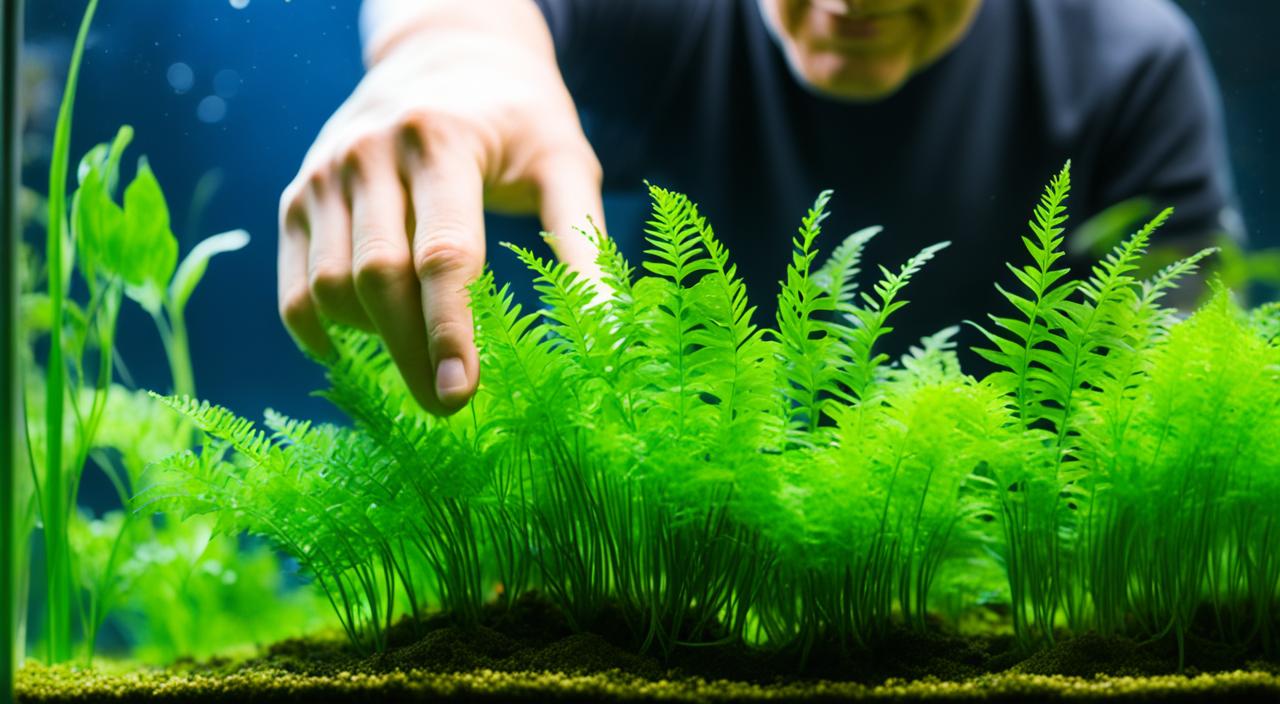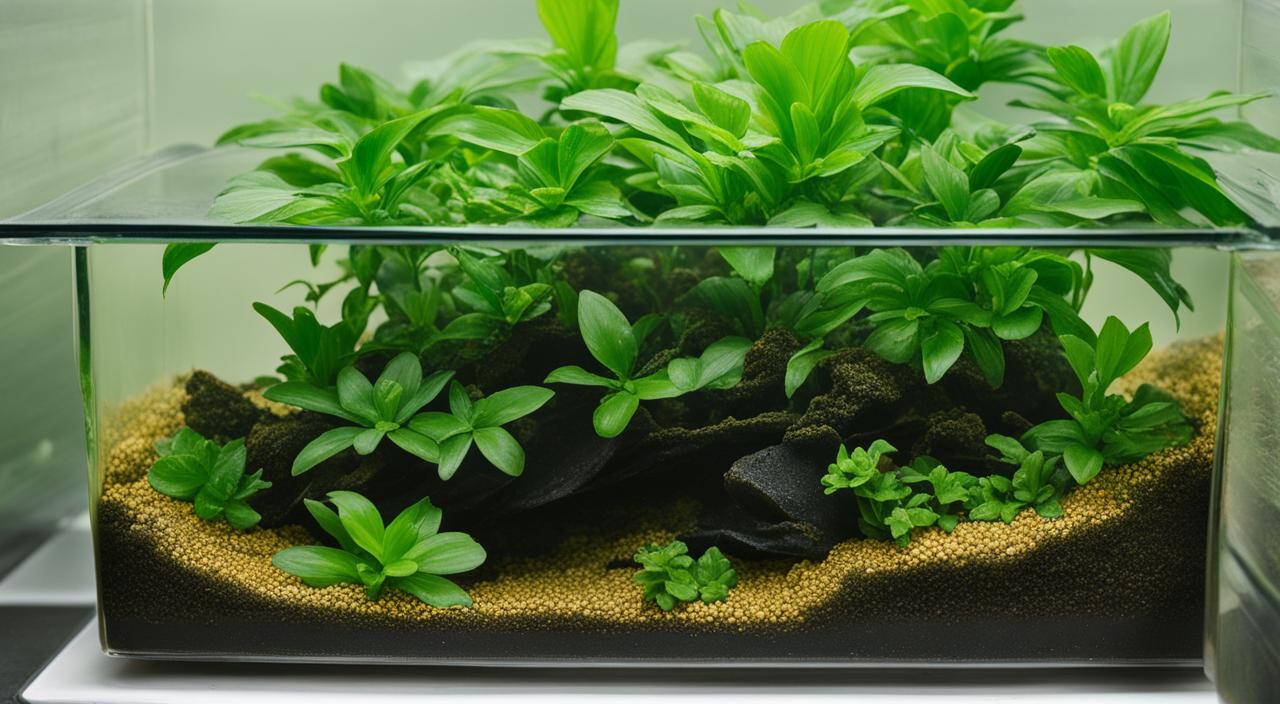As an avid aquarium enthusiast, I am always looking for unique and visually appealing freshwater plants to enhance the beauty of my aquatic setups. One such plant that has caught my attention is Microsorum pteropus ‘Trident’, also known as trident java fern. This stunning variety of java fern features long, fork-like leaves that add a captivating touch to any aquarium. Its ability to thrive in low-light conditions makes it even more appealing, making it an ideal choice for those looking to create a lush and vibrant aquascape.
In this article, I will dive deeper into the Microsorum pteropus ‘Trident’ world, exploring its origins, care requirements, and role in aquascaping. Whether you’re a seasoned aquarist or a beginner, you’ll find valuable information on successfully incorporating this beautiful plant into your freshwater aquarium.
Key Takeaways:
- Microsorum pteropus ‘Trident’ is a visually striking aquarium plant with long, fork-like leaves.
- This plant is well-suited for low-light aquarium setups, making it an excellent choice for beginners and experienced aquarists.
- Microsorum pteropus ‘Trident’ is native to Indonesia and commonly found on river and stream banks.
- When placing ‘Trident’ in your aquascape, consider its height and spread for optimal visual impact.
- Compatible tank mates for ‘Trident’ include peaceful community fish, while herbivorous fish should be avoided to prevent leaf nibbling.
Brief Overview Of Microsorum pteropus ‘Trident’
Microsorum pteropus ‘Trident’ is a versatile and easy-to-care-for plant ideal for both beginner and experienced aquarists. It can thrive in low light conditions and is compatible with various water parameters. Its unique leaf shape and vibrant green colour add visual interest and a lush aesthetic to any aquascape. Whether new to aquarium keeping or an experienced hobbyist, Microsorum pteropus ‘Trident’ is an excellent addition to your tank.
Plant Information Table:
| Attribute | Microsorum pteropus ‘Trident’ Details |
|---|---|
| 1. Scientific Name: | Microsorum pteropus ‘Trident’ |
| 2. Common Names: | Trident Java Fern |
| 3. Origin: | Southeast Asia |
| 4. Height: | 15-30 cm (6-12 inches) |
| 5. Growth Rate: | Slow |
| 6. Colour: | Dark green |
| 7. Aquarium Placement: | Midground to Background, attached to hardscape (rocks, driftwood) |
| 8. Water Type: | Freshwater |
| 9. pH: | 6.0 – 7.5 |
| 10. Care Level: | Easy |
| 11. Light Requirements: | Low to Medium. Preferred LUX: 2000-5000, PAR: 10-40, Kelvin: 5000-7000K for optimal growth and coloration. |
| 12. CO2 Requirements: | It is unnecessary but can benefit from CO2 supplementation in high-light setups. |
| 13. Temperature: | 20-28°C (68-82°F) |
| 14. Flow Rate: | Low to Moderate. Prefers gentle water movement. |
| 15. Propagation: | By rhizome division or adventitious plantlets. |
| 16. Feed Type: | It is not necessary, but it can benefit from CO2 supplementation in high-light setups. |
The light requirements for Microsorum pteropus ‘Trident’ are quite flexible, making it suitable for aquarium setups. The LUX, PAR, and Kelvin scale values provided are optimal for promoting healthy growth and maintaining the vibrant colouration of the leaves. This plant’s adaptability and unique leaf shape make it a favourite among aquascaping enthusiasts.
Origins And Habitat
Microsorum pteropus ‘Trident’ is native to Indonesia, where it grows in the banks of rivers and smaller streams. It is an aquatic fern species adapted to submerged and emersed conditions. It attaches itself to hardscape elements such as rocks and driftwood in its natural habitat, using its rhizome to anchor and absorb nutrients. This plant’s ability to grow epiphytically makes it a popular choice for aquascaping, as it adds a unique dimension to the overall design of the aquarium.
Morphological Characteristics
Microsorum pteropus ‘Trident’ is characterised by its long, fork-like leaves, giving it a distinct appearance. The leaves are attached to a rhizome, a thick stem-like structure that grows horizontally and gives rise to new leaves and roots. The rhizome should not be buried in the substrate, as it can lead to rotting. Instead, it should be attached to hardscape elements such as rocks or driftwood, allowing the plant to grow and thrive.
Placement And Lighting
When placing Microsorum pteropus ‘Trident’ in your aquascape, it is crucial to consider its height and spread. This low-light aquarium plant can thrive in environments with minimal lighting, making it an excellent choice for tanks with low-light levels. Additionally, positioning ‘Trident’ in shaded areas of the aquarium can further enhance its growth and vibrancy.
Depending on the desired effect, ‘Trident’ can be used as a background or midground plant in your aquascape. Placing it strategically in these areas can help create depth and focal points within the tank, contributing to an aesthetically pleasing and balanced overall design.
| Placement Tips | Lighting Requirements |
|---|---|
| – Consider the height and spread of ‘Trident’ when positioning it in the tank. | – ‘Trident’ is a low-light aquarium plant that can thrive in environments with minimal lighting. |
| – Use ‘Trident’ as a background or midground plant to create depth and focal points. | – Position ‘Trident’ in shaded aquarium areas to enhance its growth and vibrancy. |
What Are Good Tank Mates?
Microsorum pteropus ‘Trident’ is a peaceful aquarium plant that can coexist harmoniously with various fish species. When choosing tank mates for ‘Trident,’ it is crucial to consider compatibility and ensure the well-being of the plant and the fish in your aquarium. Good tank mates for ‘Trident’ include peaceful community fish that are known to be compatible with other species in a community setting. These fish display calm behaviours and are unlikely to disturb or damage the plant.
Good Tank Mates
- Tetras
- Rasboras
- Guppies
- Catfish
These fish species are known for their peaceful nature and ability to live peacefully in a community tank. They are unlikely to nip at or disturb the leaves of ‘Trident,’ allowing the plant to flourish and maintain its aesthetic appeal. You can create a tranquil and harmonious aquatic environment by choosing these peaceful tank mates.
Fish Species To Avoid
When selecting tank mates for ‘Trident,’ it is crucial to avoid herbivorous fish species. Herbivorous fish have a natural inclination to graze on plants and may nibble on the leaves of ‘Trident,’ hindering its growth and potentially causing damage. To ensure the well-being of your ‘Trident’ plant, it is best to avoid keeping herbivorous fish in the same tank.
Consider the size and behaviour of the fish when choosing tank mates for ‘Trident.’ Avoid species that may be aggressive, territorial, or prone to fin-nipping, as they can disrupt the overall balance and stress the plant. By selecting compatible and peaceful tank mates, you can create a harmonious and thriving aquarium environment for your fish and the ‘Trident’ plant.
Feeding (Fertilisation)
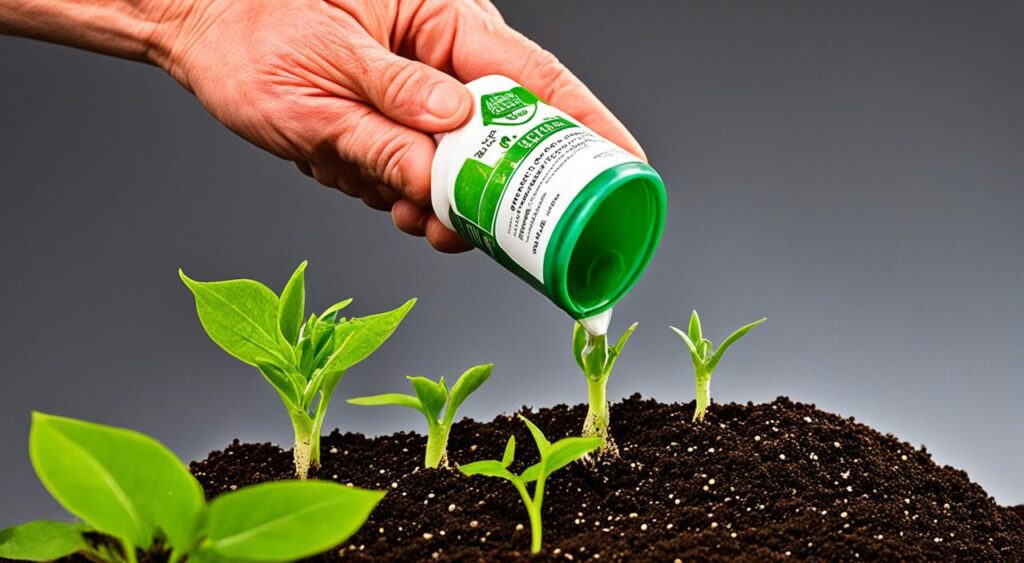
Microsorum pteropus ‘Trident’ is a relatively low-maintenance plant for feeding. It derives most of its nutrients from the water column and does not require frequent fertilisation. However, providing supplemental nutrients through liquid fertilisers can promote healthy growth and vibrant foliage.
When fertilising ‘Trident’, it is important to follow the dosage instructions provided by the manufacturer and avoid overfeeding, as excessive nutrients can lead to algae growth.
Choosing a high-quality liquid fertiliser formulated explicitly for aquarium plants is recommended. These fertilisers contain essential macronutrients and micronutrients crucial for the growth and development of ‘Trident’.
When adding liquid fertiliser to the aquarium, it is essential to distribute it evenly throughout the water column. This allows the plant’s roots and leaves to absorb the nutrients effectively.
The frequency of fertilisation depends on your aquarium’s individual needs and the plants’ specific requirements. As a general guideline, ‘Trident’ can be fertilised once or twice a month. However, it is essential to monitor the growth and health of the plant and adjust the fertilisation schedule accordingly.
Regular water changes are also essential in maintaining water quality and preventing nutrient imbalances. During water changes, it is recommended to vacuum the substrate to remove any excess debris and organic matter hindering nutrient absorption.
By providing the right balance of nutrients and maintaining optimal water conditions, you can ensure the healthy growth and vibrant appearance of Microsorum pteropus ‘Trident’ in your aquarium.
CO2 Injection
Carbon dioxide (CO2) injection is a beneficial technique for promoting the growth and health of aquatic plants, including Microsorum pteropus ‘Trident’. CO2 supplementation enhances photosynthesis, enabling faster and more robust plant growth in planted tanks.
Types
There are various methods of CO2 injection in planted tanks, allowing you to choose the one that best suits your specific requirements and desired level of plant growth. The two most common types of CO2 injection methods are:
- Pressurised Systems: Pressurised CO2 systems involve using a CO2 cylinder, regulator, and diffuser to deliver a controlled amount of carbon dioxide into the aquarium water. This method provides precise control over CO2 levels and is suitable for larger tanks.
- Liquid Carbon Supplements: Liquid carbon supplements, such as those containing glutaraldehyde, can be an alternative to pressurised CO2 systems. These supplements are added directly to the aquarium water and provide a source of bioavailable carbon for plant growth. They are cost-effective for smaller tanks or those who prefer a more straightforward CO2 injection method.
When implementing CO2 injection in your planted tank, it is essential to monitor the CO2 levels and adjust them gradually to avoid sudden fluctuations and potential stress or harm to your aquatic plants and fish.
Care
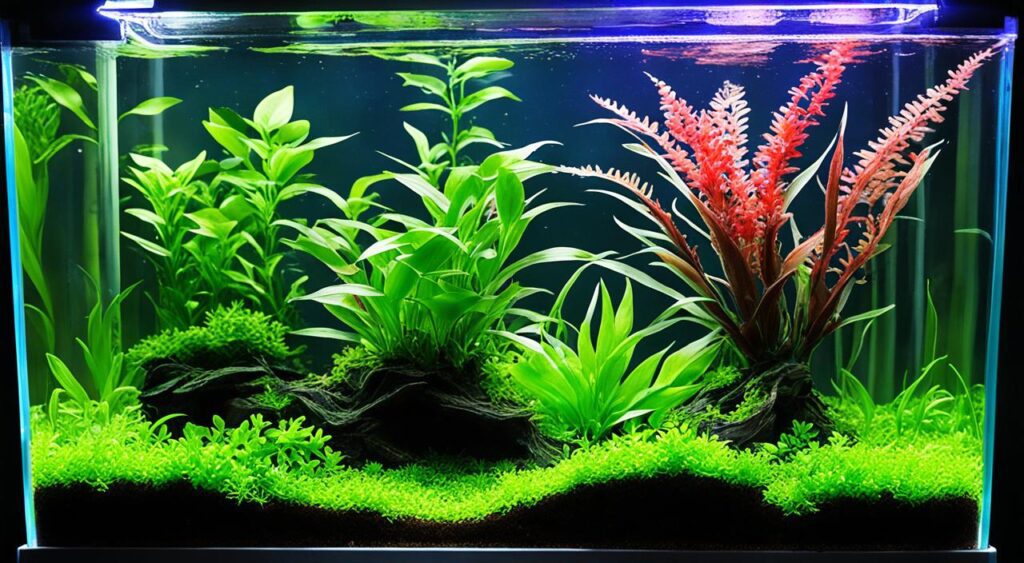
Proper care is essential for Microsorum pteropus ‘Trident’ health and well-being. When setting up a planted tank, it is crucial to consider the specific parameters that favour the growth of aquatic plants.
Planted Tank Parameters
To ensure the optimal growth of Microsorum pteropus ‘Trident’, it is essential to provide suitable water parameters. ‘Trident’ thrives in water with a pH between 6.0 and 7.5 and a temperature range of 68-82°F. These conditions mimic its natural habitat and promote healthy growth and development. Maintaining the correct parameters is crucial for the plant’s overall well-being and the aquarium’s ecosystem.
Water Quality
Adequate filtration and water quality are essential for the care of Microsorum pteropus ‘Trident’. Proper filtration systems help remove debris, waste, and excess nutrients from the water, which can lead to algae growth and negatively impact plant health. Regular water changes and maintenance routines help maintain optimal water quality and prevent the accumulation of harmful substances in the aquarium.
Filtration
When choosing a filtration system for your planted tank, consider the needs of Microsorum pteropus ‘Trident’. A high-quality filter with appropriate flow rates and filter media is essential. The filter should effectively remove toxins, maintain water clarity, and provide a suitable environment for the growth of beneficial bacteria that aid in nitrogen cycling. Adequate filtration ensures that the water remains clean and supports the health of the ‘Trident’ plant.
Flow
Proper water flow is crucial for Microsorum pteropus ‘Trident’ health and well-being. It helps distribute nutrients throughout the aquarium and prevents the stagnation of water. While ‘Trident’ thrives in low-flow conditions, it is crucial to ensure sufficient gentle water movement to maintain oxygen levels and prevent debris buildup. Striking a balance between flow and stillness is essential for the overall health of the plant and the aquarium ecosystem.
Aquarium Maintenance
Testing Water Conditions
Regular aquarium maintenance is crucial for ensuring the well-being of Microsorum pteropus ‘Trident’ and the overall health of your tank. One essential aspect of maintenance is testing water conditions regularly. By monitoring the water parameters, you can identify any imbalances or potential issues and take appropriate measures to maintain a stable environment for your aquatic plants and fish.
When testing water conditions, appropriate test kits must be used to measure parameters such as pH, ammonia, nitrite, and nitrate levels. Test kits are widely available in stores and online, providing accurate results that can guide you in maintaining optimal water quality.
How To Set Up Your Aquarium Tank
The setup of your aquarium tank plays a vital role in creating an optimal environment for Microsorum pteropus ‘Trident’ and other aquatic plants to thrive. Proper substrate choice, hardscape arrangement, and overall aquascape design contribute to your tank’s overall health and visual appeal.
When selecting a substrate, consider using a nutrient-rich substrate designed explicitly for planted aquariums. This type of substrate provides essential nutrients to the plant roots, aiding their growth and overall health. Additionally, carefully arrange hardscape elements such as rocks or driftwood, ensuring they are securely positioned in the tank and not damaging the plants or aquarium inhabitants.
Propagation Methods
Understanding and practising propagation methods specific to Microsorum Pteropus ‘Trident’ can help you expand your plant collection and promote healthy growth in your aquarium. One standard propagation method for ‘Trident’ is separating it by the rhizome.
To propagate ‘Trident’, carefully detach a portion of the rhizome with healthy leaves and roots. Then, plant the separated portion in a suitable substrate or attach it to hardscape elements. Proper care ensures the separated rhizome will develop new leaves and roots, establishing a new plant within your tank.
Propagation is an exciting way to increase the number of ‘Trident’ plants in your aquarium and experiment with different aquascape designs and layouts.
Health And Disease
Monitoring the health of Microsorum pteropus ‘Trident’ is critical to its long-term success in your aquarium. Regular observation and attention to the plant’s condition will help you identify any potential health issues and take appropriate action. Healthy ‘Trident’ plants display certain characteristics that indicate their well-being.
Signs Of Good Health
Aquarium plant health can be assessed through visual cues. Here are signs of good health in Microsorum pteropus ‘Trident’:
- Vibrant green leaves: Healthy ‘Trident’ plants have rich green foliage, indicating that they are receiving sufficient light and nutrients.
- Steady growth: A thriving ‘Trident’ plant will show consistent and steady growth, with new leaves forming regularly.
- Firmly attached roots: The roots of healthy ‘Trident’ plants should be firmly attached to the hardscape, ensuring proper nutrient uptake.
Signs Of Poor Health
Recognising signs indicating poor health in Microsorum pteropus ‘Trident’ is essential. These signs may include:
- Yellowing or dying leaves: Yellow or wilted leaves can indicate nutrient deficiencies, improper lighting, or other underlying health issues.
- Stunted growth: If your ‘Trident’ plant is not growing at a steady rate or exhibiting limited growth, it may indicate inadequate environmental conditions or nutritional imbalances.
- Signs of pest infestation: Unusual markings, webbing, or visible pests on the leaves or stem can indicate the presence of plant pests that need to be addressed promptly.
Common Health Issues And Treatment
Microsorum pteropus ‘Trident’ can experience common health issues that can compromise its well-being. Some of these issues include:
| Common Health Issues | Treatment |
|---|---|
| Nutrient deficiencies | Supplementing with appropriate liquid fertilizers or adjusting the nutrient balance in the aquarium |
| Algae overgrowth | Supplementing with appropriate liquid fertilisers or adjusting the nutrient balance in the aquarium |
| Disease | Isolating affected plants, providing appropriate treatment for the specific disease, and maintaining optimal aquarium conditions for recovery |
Plant Pests
Microsorum pteropus ‘Trident’ can also fall victim to plant pests, damaging the plant and hindering its growth. Common plant pests found in aquariums include snails, aphids, and algae-eating fish. Implementing pest control measures such as manual removal, quarantine procedures, and biological controls can help manage and prevent plant pest infestations.
Summary
Microsorum pteropus ‘Trident’ is a captivating and visually striking aquatic plant that brings beauty and depth to any aquascape. With its unique leaf shape, low-light requirements, and easy care, ‘Trident’ is an excellent choice for beginner and experienced aquarists. You can enjoy the lush green beauty of ‘Trident’ in your aquarium by providing the right environmental conditions, proper nutrition, and regular maintenance.
Whether you are creating a nature-inspired scape or a vibrant freshwater community tank, Microsorum pteropus ‘Trident’ is sure to make a stunning addition. Its long, fork-like leaves add a touch of elegance and create a visually appealing focal point in your aquascape. ‘Trident’ is well-suited for low-light aquarium setups, making it a versatile choice for various tank styles.
To ensure the optimal growth and health of ‘Trident,’ provide the right conditions. This includes placing it in a suitable light level, considering its height and spread, and ensuring proper water parameters. Regular maintenance, such as pruning and water changes, is crucial to keep ‘Trident’ and the aquarium ecosystem healthy.
In conclusion, Microsorum pteropus ‘Trident’ is a stunning and easy-to-care-for aquatic plant that adds a lush and vibrant touch to your aquarium. With its unique characteristics and adaptability, ‘Trident’ is a must-have for any aquascape enthusiast. By incorporating ‘Trident’ into your tank, you can create a beautiful underwater world that captivates and delights you and your fish.
FAQ
What is Microsorum pteropus ‘Trident’?
Microsorum pteropus ‘Trident’, also known as trident java fern, is a variety of the popular aquarium plant, Java Fern. It is characterized by its long, fork-like leaves, giving it an interesting and visually appealing appearance.
Is Microsorum pteropus ‘Trident’ suitable for beginners?
Yes, Microsorum pteropus ‘Trident’ is a beginner-friendly plant that is well-suited for low-light aquarium setups. It is a versatile and easy-to-care-for plant that can thrive in a wide range of water parameters.
Where is Microsorum pteropus ‘Trident’ native to?
Microsorum pteropus ‘Trident’ is native to Indonesia, where it grows in the banks of rivers and smaller streams.
How should Microsorum pteropus ‘Trident’ be planted in an aquarium?
The rhizome of Microsorum pteropus ‘Trident’ should not be buried in substrate. Instead, it should be attached to hardscape elements such as rocks or driftwood, allowing the plant to grow and thrive.
What kind of lighting does Microsorum pteropus ‘Trident’ require?
Microsorum pteropus ‘Trident’ is a low-light aquarium plant and can thrive in environments with minimal lighting. It is an excellent choice for tanks with low light levels or shaded areas of the aquarium.
What fish can coexist with Microsorum pteropus ‘Trident’?
Good tank mates for Microsorum pteropus ‘Trident’ include peaceful community fish such as tetras, rasboras, guppies, and catfish. It is important to avoid keeping herbivorous fish with ‘Trident’ as they may nibble on the leaves and hinder its growth.
How often should Microsorum pteropus ‘Trident’ be fertilized?
Microsorum pteropus ‘Trident’ derives most of its nutrients from the water column and does not require frequent fertilization. However, providing supplemental nutrients through the use of liquid fertilizers can promote healthy growth and vibrant foliage.
Is CO2 injection necessary for Microsorum pteropus ‘Trident’?
While not necessary, CO2 injection can be beneficial for the growth and health of aquatic plants, including Microsorum pteropus ‘Trident’. It enhances photosynthesis, enabling faster and more robust growth.
What are the care requirements for Microsorum pteropus ‘Trident’?
Microsorum pteropus ‘Trident’ thrives in water with a pH between 6.0 and 7.5 and a temperature range of 68-82°F. Adequate filtration, water flow, and regular maintenance are also crucial for its health and well-being.
How do I propagate Microsorum pteropus ‘Trident’?
Microsorum pteropus ‘Trident’ can be propagated by separating the rhizome. This involves carefully cutting or breaking off a portion of the rhizome and attaching it to a new hardscape element.
What are the signs of good and poor health in Microsorum pteropus ‘Trident’?
Healthy Microsorum pteropus ‘Trident’ plants have vibrant green leaves, steady growth, and roots that are firmly attached to the hardscape. Signs of poor health include yellowing or dying leaves, stunted growth, or signs of pest infestation.
What are some common health issues for Microsorum pteropus ‘Trident’?
Common health issues for Microsorum pteropus ‘Trident’ include nutrient deficiencies, algae overgrowth, and disease. Proper care practices, maintaining water quality, and addressing issues promptly can help prevent and treat these problems.
Can Microsorum pteropus ‘Trident’ be used in aquascapes?
Yes, Microsorum pteropus ‘Trident’ is a captivating and visually striking aquarium plant that adds beauty and depth to aquascapes. Its unique leaf shape, low-light requirements, and easy care make it an excellent choice for both beginners and experienced aquarists.

